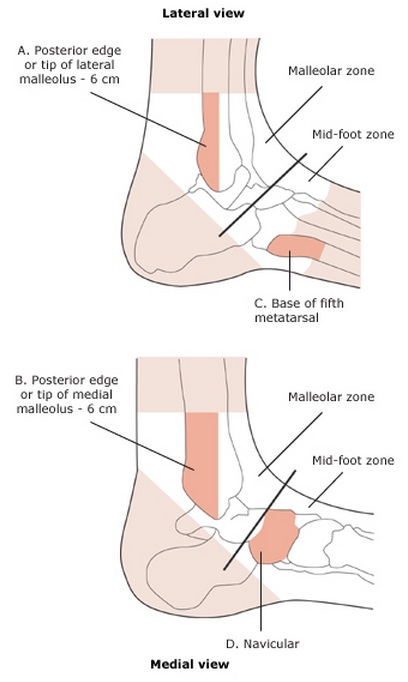Ottawa ankle rules: Difference between revisions
Ostermayer (talk | contribs) (→Source) |
No edit summary |
||
| Line 1: | Line 1: | ||
==Ankle | ==Ankle== | ||
*X-ray is only required if there is pain in the malleolar zone AND any of these findings: | *X-ray is only required if there is pain in the malleolar zone AND any of these findings: | ||
| Line 12: | Line 12: | ||
==Exceptions== | ==Exceptions== | ||
# | #Age <6 or >55 | ||
#Only for blunt trauma mechanism | #Only for blunt trauma mechanism | ||
#Does not apply to subacute/chronic injuries | #Does not apply to subacute/chronic injuries | ||
| Line 28: | Line 27: | ||
* | * | ||
== | ==Sources== | ||
#Bachmann LM, Kolb E, Koller MT, et al. Accuracy of Ottawa ankle rules to exclude fractures of the ankle and mid-foot: systematic review. BMJ. 2003 Feb 22;326(7386):417. | |||
#Bauer SJ, Hollander JE, Fuchs SH, et al. A clinical decision rule in the evaluation of acute knee injuries.J Emerg Med. 1995 Sep-Oct;13(5):611-5. | |||
#Dowling S, Spooner CH, Liang Y, et al. Accuracy of Ottawa Ankle Rules to exclude fractures of the ankle and midfoot in children: a meta-analysis. Acad Emerg Med. 2009 Apr;16(4):277-87. | |||
#Stiell IG, Greenberg GH, McKnight RD, et al. A study to develop clinical decision rules for the use of radiography in acute ankle injuries. Ann Emerg Med. 1992 Apr;21(4):384-90. | |||
#Stiell IG, McKnight RD, Greenberg GH, et al. Implementation of the Ottawa ankle rules. JAMA. 1994 Mar 16;271(11):827-32. | |||
#Stiell I, Wells G, Laupacis A, et al. Multicentre trial to introduce the Ottawa ankle rules for use of radiography in acute ankle injuries. Multicentre Ankle Rule Study Group. BMJ. 1995 Sep 2;311(7005):594-7. | |||
[[Category:Ortho]] | [[Category:Ortho]] | ||
Revision as of 06:59, 6 June 2014
Ankle
- X-ray is only required if there is pain in the malleolar zone AND any of these findings:
- Bony tenderness along the posterior edge or distal 6cm of either malleolus
- Inability to bear weight for at least two steps with each foot immediately after the injury AND at the time of evaluation
Foot
- X-ray is only required if there is pain in midfoot zone AND any of these findings:
- Bony tenderness over the navicular bone
- Bony tenderness over base of the 5th metatarsal
- Inability to bear weight for at least two steps with each foot immediately after the injury AND at the time of evaluation
Exceptions
- Age <6 or >55
- Only for blunt trauma mechanism
- Does not apply to subacute/chronic injuries
- Does not apply to injuries of the hindfoot or forefoot
Imaging
See Also
http://www.ncbi.nlm.nih.gov/pubmed/18955612
Sources
- Bachmann LM, Kolb E, Koller MT, et al. Accuracy of Ottawa ankle rules to exclude fractures of the ankle and mid-foot: systematic review. BMJ. 2003 Feb 22;326(7386):417.
- Bauer SJ, Hollander JE, Fuchs SH, et al. A clinical decision rule in the evaluation of acute knee injuries.J Emerg Med. 1995 Sep-Oct;13(5):611-5.
- Dowling S, Spooner CH, Liang Y, et al. Accuracy of Ottawa Ankle Rules to exclude fractures of the ankle and midfoot in children: a meta-analysis. Acad Emerg Med. 2009 Apr;16(4):277-87.
- Stiell IG, Greenberg GH, McKnight RD, et al. A study to develop clinical decision rules for the use of radiography in acute ankle injuries. Ann Emerg Med. 1992 Apr;21(4):384-90.
- Stiell IG, McKnight RD, Greenberg GH, et al. Implementation of the Ottawa ankle rules. JAMA. 1994 Mar 16;271(11):827-32.
- Stiell I, Wells G, Laupacis A, et al. Multicentre trial to introduce the Ottawa ankle rules for use of radiography in acute ankle injuries. Multicentre Ankle Rule Study Group. BMJ. 1995 Sep 2;311(7005):594-7.



